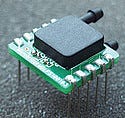July 2, 2009
Originally Published MPMN July 2009
BREAKTHROUGHS
Breathing Life into Differential-Pressure Sensor Technology
|
Microbridge's thermoanemometer-type airflow sensor reduces package size and enhances measurement of low differential pressures. |
In the medical device world, miniaturization is the name of the game—especially when it comes to handheld devices. However, to meet the demands of ever-shrinking devices, component manufacturers are under constant pressure to engineer miniature parts. One such manufacturer, Microbridge Technologies Canada, has developed a thermoanemometer-type airflow microsensor that the company says will reduce package size and enhance measurement of low differential pressures.
“This differential-pressure sensor is well suited for use in airflow applications that measure human respiration phenomena,” explains Les Landsberger, Microbridge’s CTO. The sensor, he adds, can be incorporated into a range of medical devices that measure respiration, including artificial lung ventilators, spirometers, sleep-apnea devices, and oxygen ventilators.
One type of differential-pressure sensor technology measures pressure by deflection of a dead-end-type membrane. However, to be sensitive enough to measure the low levels of differential pressures required in respiration equipment, the membranes would have to be very thin, very large, or both. Difficult to manufacture, such membranes would result in large and expensive sensors.
In contrast, Microbridge’s sensor technology measures pressure when a small amount of air flows through a channel over a heating element surrounded on either side by two resistors. The heated air is displaced by airflow in one direction or the other, which in turn unbalances the temperatures in the resistors. The speed with which the air flows through the channel is determined by the difference in pressure between the two ends of the flow channel and by the channel’s flow impedance.
While the air passage in differential-pressure sensors is typically formed in the surrounding packaging or housing, Microbridge’s technology features an integrated on-chip air passage with controllable dimensions and alignment. This design reduces the amount of air that must pass over the heating element and reduces air leakage through the sensor. The sensor measures differential pressure between two points along a breathing tube, which is translated into breathing flow, Landsberger notes.
In addition to its small size and sensitivity, the sensor can be replaced in the field without requiring calibration. Its pressure range is determined by the die-level flow impedance and on-chip amplification. Featuring analog CMOS signal conditioning circuitry and analog adjustability using Rejustors, offset and amplification are adjustable on the chip.
“Because our sensor can be made smaller than the competition’s, it can be used in medical devices intended for home-care and portable use,” says Landsberger. “Because its flow-through leakage is small, it behaves like a dead-end-type membrane-based sensor. It is also easy and flexible to use with filters or connection hoses.”
Microbridge Technologies Canada
MONTREAL
www.mcbridgetech.com
Copyright ©2009 Medical Product Manufacturing News
You May Also Like



